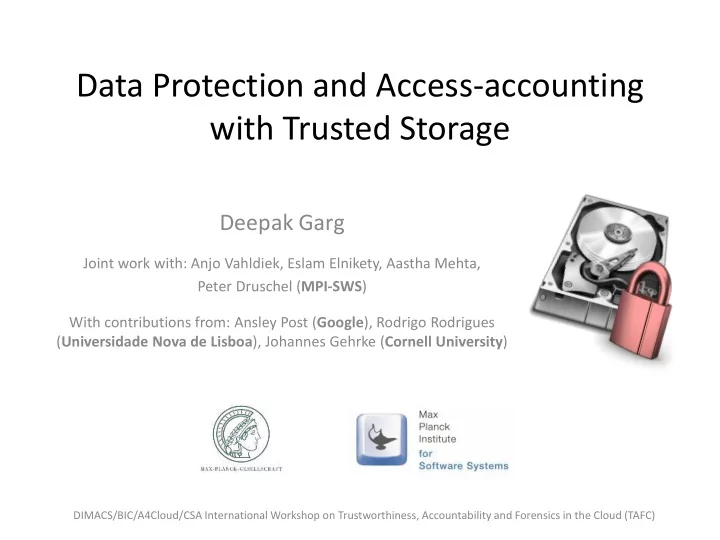

Data Protection and Access-accounting with Trusted Storage Deepak Garg Joint work with: Anjo Vahldiek, Eslam Elnikety, Aastha Mehta, Peter Druschel ( MPI-SWS ) With contributions from: Ansley Post ( Google ), Rodrigo Rodrigues ( Universidade Nova de Lisboa ), Johannes Gehrke ( Cornell University ) DIMACS/BIC/A4Cloud/CSA International Workshop on Trustworthiness, Accountability and Forensics in the Cloud (TAFC)
Motivation: Data Protection and Accountability in the Cloud • Growing data in third-party environments (e.g., Clouds) • Data protection and access-accounting necessary – Legal and organizational mandates – Loss of confidentiality, integrity, access accounts costly – (E.g., electronic medical records, financial, corporate data) • Increasingly complex storage infrastructure, administration • Many threats, despite best intentions of Cloud provider – Hardware failures, defects – Software bugs, vulnerabilities – Misbehaving apps – Human errors (e.g., misconfigurations) • Goal: Provide data confidentiality, integrity and access accounting, with minimal trust in storage infrastructure. • Scope: Persistently stored data. Currently, confidentiality, integrity, verifiability, access-accounting (privacy next step)
Trusted Storage Application File system Disk driver Policy enforcement Virtual Machine Monitor (Trusted Storage File system Networked FS Controller) i Disk driver Net stack Trust = Several Net driver interfaces + ~10 6 - 10 7 LoC Trust = One interface + ~10 5 - 10 6 LoC
Trusted Storage Controller (TSC) • An interpreter for very rich policies • Policies are provided in a declarative language, by applications • Policies are applied to all reads and writes by TSC (confidentiality and integrity) • TSC can attest state of stored data with embedded private key (verifiability) • Additionally, TSC implements: – An object-level API for stored data – A transaction semantics on individual objects (facilitates integrity checks) – Authentication protocols, cryptographic channels – Verification of third-party policy certificates (e.g., x.509 or XACML) – Access to object content during policy evaluation – Primitives for opaquely migrating stored objects between TS devices • How is additional functionality available to higher layers? (IOCTL?) • Applications, Cloud orchestrate data operations (as usual), but data security relies on TSC
Trusted Storage Use Application Access policy relying on: File system - Client authentication Disk driver - Certified facts (time, location) - Current object state - New object state (update) Virtual Machine Monitor File system Networked FS Attestation containing: i Disk driver Net stack - Object size - Object policy hash Net driver - Object content hash - Object id (pathname)
Threat Model • Threat model: Honest, but curious or buggy provider – Bugs in storage infrastructure – Misconfigurations • Must trust: – Trusted storage controller – External dependencies of policy (e.g., time server) – No physical attacks on TS enclosure • Guarantee: All access complies with policy • TS provides data confidentiality, integrity, verifiability and access accounting ( not availability)
Example 1: Backup File Integrity • Threat: Software bug, virus or operator error corrupts backup data stored in the Cloud • Policy: No update before backup expiration date update :- key_is (K, “ TimeServer ”) ∧ External policy dependency K signs time(T ) ∧ T >= expT read :- <no constraints>
Example 2: Append-only Log • Threat: Accidental or malicious truncation of system log file • Policy: Allow only appends, except to a trusted system administrator Refers to both update :- (old_extents_are(Oext) ∧ old and new structure new_extents_are(Next) ∧ is_prefix(Oext, Next)) ∨ session_is(k ad ) read :- <no constraints>
Example 3: Mandatory Access Logging • Threat: Unaccounted access to data (e.g., medical records, pay-per-view content) • Policy: Access allowed if descriptive entry is added to a designated append-only log file Content file has a seq#, forcibly incremented during update - Read needs log entry <client, current seq#, locus> - Write needs log entry <client, new seq#, locus, content hash> State machine; needs atomic update transactions
Evaluation • Prototype in an iSCSI Enterprise Target (IET) SAN server, with small Flash memory for metadata • Microbenchmarks: – Small throughput overhead (<0.75%) – Low (<0.5%) latency cost, except sequential read/write (2%/7%) • Applications: – Webserver: TS makes log files append-only, protects content from unauthorized modification – Secure migration by storage provider: TS prevents third-party provider from reading data, but allows migration; forces N (>1) replicas at all times – Mandatory access logging: TS forces logs on all reads and writes, ensures consistency during synchronization of independently modified replicas (in progress)
Conclusion • TS enforces application-defined policies on stored objects, attests objects • Rich policies, enable confidentiality, integrity, access- accounting • Relies only on TSC and policy dependencies • Efficiently implementable • Next work: TSC implemented in a VMM, information flow control in the Cloud (goal: privacy) • Open questions (for future revisions) – A comprehensive study of security and privacy requirements for Cloud apps? – What do legal requirements entail for security primitives needed in the Cloud?
Recommend
More recommend